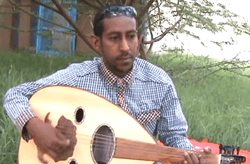Oud facts for kids
 |
|
| String instrument | |
|---|---|
| Classification |
|
| Related instruments | |
The oud (pronounced "ood") is a fascinating musical instrument that looks a bit like a pear! It's a type of string instrument, which means it makes music when you pluck or strum its strings. You might think it looks a little like a guitar, but it's actually more similar to an ancient instrument called a lute. One big difference is that the oud doesn't have frets. Frets are those thin metal strips you see on a guitar's neck that help players find the right notes. The oud is very popular in Middle Eastern music and East African music, and it has a truly special, warm sound.
Contents
What is an Oud?
The oud is a beautiful instrument with a deep, rounded body, much like half a pear. It usually has 11 or 13 strings, which are often grouped into pairs. The strings are made of materials like nylon or gut. Unlike a guitar, the oud has a short neck without frets. This allows players to slide their fingers smoothly along the strings. This creates unique sounds and melodies. The headstock, where the tuning pegs are, often bends backward. This gives the oud its distinctive look.
How the Oud Makes Music
To play the oud, musicians use a plectrum, which is a small pick. They pluck the strings to create melodies. Because there are no frets, players rely on their ear and finger placement. This takes a lot of skill and practice! The oud's sound is often described as rich, warm, and soulful. It can be used to play fast, lively tunes or slow, emotional pieces. Its unique sound is a big part of the music from its home regions.
Where is the Oud Played?
The oud is a central instrument in many cultures. It is especially important in the Middle East, North Africa, and parts of East Africa. Countries like Egypt, Syria, Iraq, Turkey, Iran, and Greece all have strong oud traditions. Each region might have its own style of playing or slightly different types of ouds. It's often played in traditional music groups. It can also be heard in modern pop songs.
The Oud in Different Cultures
In Arab culture, the oud is sometimes called the "sultan of instruments." This shows how much it is respected. It's used in classical music, folk music, and even religious ceremonies. In Turkish music, the oud is also very important. It helps create the unique sounds of makam music. This is a system of melodic modes. The oud's ability to play microtones (notes between the standard notes on a piano) makes it perfect for these complex musical styles.
A Brief History of the Oud
The oud has a very long and interesting history. Instruments similar to the oud have been played for thousands of years. Early versions can be seen in ancient carvings from Mesopotamia. This is an area in the Middle East. The oud as we know it today developed over many centuries. It became popular during the Islamic Golden Age. This was a time of great learning and art.
From Ancient Times to Today
During the Middle Ages, the oud traveled from the Middle East to Europe. It influenced the development of the European lute. This shows how musical ideas can spread across the world. Famous musicians and scholars played and wrote about the oud. They helped make it a respected instrument. Today, the oud continues to be played by many musicians. It is loved for its beautiful sound and rich history.
Images for kids
See also
 In Spanish: Laúd árabe para niños
In Spanish: Laúd árabe para niños



